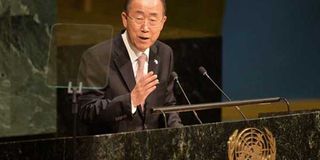Why the new development goals may not fare much better than the MDGs

UN Secretary-General Ban Ki-moon speaks during the 70th session of the UN General Assembly on September 25, 2015 in New York. Now the UN has proposed 17 new Sustainable Development Goals. PHOTO | DOMINICK REUTER | AFP
What you need to know:
- These Millennium Development Goals set the stage for new national and global programmes and determined the funding priorities of donors.
- China’s high economic growth in the past 30 years may have lifted millions of people out of poverty, but China’s cities are today choking from pollution.
- Furthermore, an offshore network of tax havens has allowed large multinational corporations to channel up to half of their investments in Africa through a tax haven.
In 2000, United Nations member states committed themselves to halving the number of people who live in extreme poverty, achieving universal primary education, promoting gender equality, reducing child and maternal mortality, reversing and halting the spread of HIV, ensuring environmental sustainability, and developing a global partnership for development by 2015.
These Millennium Development Goals set the stage for new national and global programmes and determined the funding priorities of donors.
We have now reached the deadline for the MDGs.
Progress varies from country to country. There has certainly been a remarkable decrease in HIV prevalence in countries such as Kenya and a number of others have made some improvements in reducing poverty.
Now the UN has proposed 17 new Sustainable Development Goals. Unfortunately, some of them are so broad and abstract that it is highly unlikely that they will be achieved.
Take Goal 1: “End poverty in all its forms everywhere.” Is this really possible given than two-thirds of the world lives on less than $5 a day? What about Goal 12: “Ensure sustainable consumption and production patterns.” Is this realistic, given that consumption and production form the basis of modern capitalist economies?
CAUSES OF POVERTY
The new goals have also placed economic growth at the centre of all poverty reduction policies.
Unfortunately, production- and consumption-driven growth has led to the ruin of the planet. China’s high economic growth in the past 30 years may have lifted millions of people out of poverty, but China’s cities are today choking from pollution.
More importantly, the structural and historical causes of poverty have not been addressed at all and, therefore, chances of eradicating it remain elusive.
Poverty does not just happen; it is created, just like wealth. It took Europe and North America some 400 years to become rich.
This wealth was the end result of 400 years of slavery, colonialism, and innovations in technology that led to the Industrial Revolution.
Wealth was produced by slaves, extracted from colonies, and sustained through technology that allowed mass production. So some people had to remain poor and exploited so others could become rich.
When slavery and colonialism ended, wealthy countries continued to control former colonies through donor policies that created a state of dependency (i.e. poverty) in countries that received their aid and loans.
STEALING RESOURCES
Aid also masks the fact that some of the biggest donors to Africa are also draining or stealing the continent’s natural and other resources. The new goals are silent on this exploitation of African countries’ resources.
A report by a network on NGOs in the UK found that while aid to Africa amounts to less than $30 billion a year, the continent is losing $192 billion annually, mainly through profits made by foreign multinational companies, debt payments to international financial institutions (often on irresponsible loans), illicit financial flows, tax evasion, and illegal logging and fishing.
This figure includes the estimated $6 billion that Africa loses to brain drain. Even when financial inflows such as foreign investment and loans are taken into consideration, the continent still suffers a loss of $58 billion a year.
Ironically, African countries with the most natural resources tend to also be the poorest.
Furthermore, an offshore network of tax havens has allowed large multinational corporations to channel up to half of their investments in Africa through a tax haven.
MONEY LAUNDERING
Laundering of dirty money is also facilitated by these tax havens. Shell banks and companies that hide corrupt deals contribute to the illicit flow of money out of the continent.
African countries are also to blame for much of this leakage. Mega-corruption scandals have diverted taxpayers’ money into the pockets of corrupt local and foreign individuals.
In Kenya, as much as a third of the country’s budget is regularly unaccounted for.
Meanwhile, expect many expensive conferences and workshops on the Sustainable Development Goals over the next 15 years.
Donors will adjust their priorities to help poor countries meet these goals. Some of the aid will be stolen, some of it will be wasted or mismanaged.
Poor countries will adjust their national development plans based on these goals. Then in 2030, the UN will set another target for poverty reduction.





